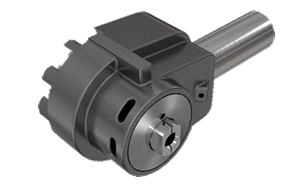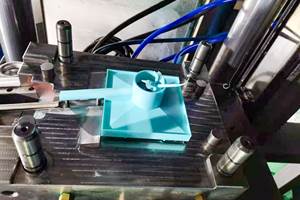EMO Q&A: Will Additive Manufacturing Put Milling Machines Out of Work?
Interview with Andrzej Grzesiak, who heads the Fraunhofer Additive Manufacturing Alliance, in the run-up to EMO Hannover 2011.
If you’re building a house, you’re hardly going to mill rooms, doors and windows out of a huge block of stone. When it comes to machine housings made of metal, however, this is the norm – for the time being. Although the EMO Hannover 2011, as one of the world’s premier platforms for innovation, under its motto of “More than machine tools”, will be opening up the shop window of additive manufacturing just a little, this technology is hardly going to leave foresightful machine tool manufacturers cold. We talked about this to Andrzej Grzesiak, who heads the Fraunhofer Additive Manufacturing Alliance at the Stuttgart-based Fraunhofer Institute for Production Technology and Automation (IPA).
What advantages does additive manufacturing have in regard to producing complex geometries?
Grzesiak: The salient advantage of layer-forming processes is that any con-ceivable shape that can be created in a 3D CAD program can actually be produced. There are no restrictions in terms of manufacturing transparent or hollow structures. Nor are there any problems with complex geometries and freeform designs.
Additive manufacturing was at first reserved for making models and prototypes – where are the practical applications in terms of series production?
Grzesiak: We’re only at the very beginning of developments. New, improved materials and more stable processes are being developed. Nonetheless, we’re already seeing the first best-case applications with implants, dental technology and light automation components. Individualised mass production is up and running almost everywhere in these fields. We’re also seeing new applications in aircraft manufacture, where metal-based lightweight construction using titanium is set to play a particularly large role.
Are there any limits to creative design freedom – will traditional design guidelines be rendered obsolete?
Grzesiak: Direct, fast manufacturing by means of additive processes, thanks to its well-nigh limitless freedom in terms of shape and design, enables cus-tomised, optimum products to be created. By virtue of the geometric freedom provided, and the high elasticity of the material involved, moreover, it is possi-ble to manufacture snap-fit connections, complicated form-locking elements, spring-force connections and geometries like leaf springs or helical springs. This means fewer parts have to be mounted or connected with tools. This is something design engineers first have to learn.
Where do you see the main application categories for additive manufacturing – medical technology, mechanical engineering, tool and die construction, aerospace?
Grzesiak: All these fields are of interest. We draw distinctions here not by sectors, but by applications. In all of them, individualised mass production for specialised parts and components can be achieved at affordable prices.
Are there any differences in the user target groups – between micro-systems engineering and forging-die production, for example?
Grzesiak: Yes, simply because quite different requirements are posed for the engineering and the materials involved. Quite different technologies will be used here, too. It’s important not to introduce additive manufacturing tech-niques everywhere, but first to comprehend what the customers actually need. This will enable additional markets like biotechnology to be successfully pene-trated as well.
Which of the various methods for additive manufacturing has the best prospects for broadly based industrial adoption in the long term?
Grzesiak: You shouldn’t compare the various technologies directly. Depending on the particular application being planned, you have to choose the appropri-ate technology. This is also important for newcomers: first the application, then the technology. Nowadays, the laser systems are being used especially in the field of end-part production. In future, printing technology systems will be used more and more, particularly in micro-systems engineering and biotechnology. There’s going to be a lot happening here in the next three to five years.
What role does additive manufacturing play nowadays in automated process chains?
Grzesiak: None as yet. Although the integration of new manufacturing meth-ods into industrial process chains offers far-reaching options for optimising production operations, due to the lack of organisation and the stand-alone machines the implementation status is as yet not very far advanced. By rea-son of minimal batch sizes and the elimination of assembly processes thanks to complete manufacture, there is concomitant potential for streamlining, though this, of course, has to be supported by the correct organisation. Addi-tive manufacturing enables certain problems to be solved in conventional production structures, though the integration of these systems in the triangular matrix of time/costs/quality is being rendered rather difficult by the current lack of comprehensive production models.
How about the reproducibility of the processes involved, about quality assurance in mass production? Are there any dependable methods of simulation?
Grzesiak: The reproducibility of the processes involved is a principal focus of ongoing development work, and will have to be achieved over the next few years. The subject of quality is dealt with in VDI Guideline 3405, entitled “Addi-tive manufacturing processes”. There are numerous research projects running at the moment, as well as in-house development work at the equipment pro-ducers, who then address the issue.
Can additive manufacturing entirely replace conventional processes?
Grzesiak: No, nor should this be the goal of development work. The right approach is to define the correct application categories and to replace existing conventional technologies only where commercial and technical advantages are to be gained. The technologies should co-exist and complement each other to optimum effect.
So there’s no risk that additive manufacturing will in the long term put conventional machine tools out of work?
Grzesiak: You should never say never, but I don’t think so. Both technologies simply have their own advantages that can be selectively utilised. There are, however, certain fields, such as dental prosthetics, in which the machine tool will in my estimation be replaced over the next few years.
Against this background, what do you expect from the upcoming EMO Hannover 2011?
Grzesiak: The major machine tool producers are showing progressively more interest in additive manufacturing. In the final analysis, every machine that processes and produces workpieces is a manufacturing machine. Whether this is to be done with a laser or a milling head will in future be a matter of choice. Perhaps the first developments will already be on show at the EMO Hannover 2011. I am confident that if it doesn’t happen this year, it definitely will soon afterwards.
The interview was conducted by Walter Frick, freelance specialized journalist.
Background: EMO Hannover 2011 – the world’s premier trade fair for the metalworking sector
From 19 to 24 September 2011, international manufactures of production technology, “more than machine tools!” will be presenting their current capabilities at the EMO Hannover. The world’s premier trade fair for the metalworking sector will be showcasing the entire bandwidth of modern-day metalworking technology, the heart of every industrial production operation. It will be showcasing the very latest machines, plus efficient technical solutions, product-supportive services, sustainability in the production process, and much, much more. The EMO’s principal focus is on cutting and forming machine tools, production systems, high-precision tools, automated material flows, computer technology, industrial electronics and accessories. The trade visitors to the EMO come from all major industrial sectors, like machinery and plant construction, the automotive industry and its component suppliers, aerospace technologies, precision mechanics and optics, shipbuilding, medical technology, tool and mould building, steel and lightweight engineering. The EMO Hannover is the biggest international meeting point for production technology anywhere in the world. The last EMO Hannover fair in 2007 was the venue for 2,120 exhibitors on approximately 180,200 m² of net exhibition floor space, attracting more than 166,500 trade visitors from 80 different countries. EMO is a registered trademark of CECIMO, the European Association of Machine Tool Industries.
Fraunhofer Institute for Production Technology and Automation IPA
Dipl.-Ing. (FH) Andrzej Grzesiak
Leiter der Fraunhofer Additive Manufacturing Alliance
Nobelstr. 12
D-70569 Stuttgart
Tel. +49 711 970-1746
andrzej.grzesiak@ipa.fraunhofer.de
www.ipa.fraunhofer.de
www.generativ.fraunhofer.de
Related Content
Technology Roundup: Additive Manufacturing, Mold Materials
Upgrade your manufacturing process or tool steel choices with new/improved additive manufacturing and mold material innovations from AddUp Inc., Mantle, Next Chapter Manufacturing, Edro and more.
Read More3D Printing Enables Better Coolant Delivery in Milling Operations
Just like 3D printing enabled conformal cooling channels in molds, additive manufacturing is now being used to optimize coolant delivery in cutting tools.
Read MoreEvaluating Metal Powders for Conformally Cooled Mold Inserts
Mechanical properties and design software techniques reveal the benefits of a modified high thermal conductivity metal powder for 3D printing in moldmaking.
Read MoreProducts and Services for Multiple Moldmaking Needs
New year, new technology roundup! Featured here is a collection of product offerings, from profile milling cutters to industry-specific CAD/CAM software to innovative hot work tool steels.
Read MoreRead Next
How to Use Strategic Planning Tools, Data to Manage the Human Side of Business
Q&A with Marion Wells, MMT EAB member and founder of Human Asset Management.
Read MoreAre You a Moldmaker Considering 3D Printing? Consider the 3D Printing Workshop at NPE2024
Presentations will cover 3D printing for mold tooling, material innovation, product development, bridge production and full-scale, high-volume additive manufacturing.
Read MoreReasons to Use Fiber Lasers for Mold Cleaning
Fiber lasers offer a simplicity, speed, control and portability, minimizing mold cleaning risks.
Read More.jpg;maxWidth=970;quality=90)
















_300x250 4.png;maxWidth=300;quality=90)
.jpg;maxWidth=300;quality=90)







